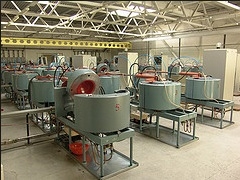Articles and News
EXCLUSIVE! RECYCLED AND SYNTHETIC DIAMONDS WILL DRAMATICALLY IMPACT PRICE EQUATION, SAYS EXPERT | March 26, 2013 (0 comments)

Tel Aviv, Israel—At the close of the first US-International Diamond Week here, renowned diamond industry analyst Chaim Even-Zohar, president of Tacy Ltd., gave attendees an overview of the global diamond market. While he touched lightly on the issue of finance—a central focus for diamond industry in the past few years—he says the industry is underestimating both the impact of recycled diamonds on prices, and the presence of undetected synthetics leaking into supply. (At left, diamond-growing equipment.)
Even-Zohar offered The Centurion some exclusive comments about his analysis of the market.
In terms of finance, he told attendees that although diamond manufacturers overall lost money in 2011 and 2012, their financial situation actually has never been better. As a result of the financial crisis, manufacturers have injected equity into their companies, and borrowing has fallen. But he cautioned that too-tight credit won’t help the industry: it’s imperative that banks be willing to provide credit for the diamond industry to survive and expand.
Even-Zohar does not expect rough diamond prices in 2013 and 2014 to rise significantly, but he does believe prices will continue to be volatile.
Recycled diamonds—those coming back into the market from consumers via jewelers, pawnshops, and other buyers—are having a significant impact on pricing. Apart from the fact that stones bought off the street have the best resale margins for jewelers, they’re also a force to be reckoned with on the wholesale end. Global annual rough sales were $15 billion last year and polished sales were $22 billion—meaning diamond manufacturers’ profits amounted to just $7 billion, he said.
“In 2012, we have calculated that some $1.2 billion (at wholesale polished prices) came back into the diamond jewelry market,” he told The Centurion.

Diamond analyst Chaim Even-Zohar
“Since ancient days, mines produced some 5.69 billion carats, which at 2012 rough production values (US $110 per carat), would amount to some US $626 billion worth of rough. The historically adjusted polished output would be between 1.3 and 1.8 billion carats. The world probably now has about US $750 billion to one trillion dollars’ worth of polished diamonds at current prices (or about 1.0 to 1.5 billion carats) in consumer hands,” he said, with between 40% and 50% of them being held in the United States.
By his calculations, if all the existing diamonds held by consumers were to go back into the market, it would supply the industry for 40 to 50 years.
“Those are the kind of volumes we’re talking about,” he said. “Recycling will significantly affect demand for fresh polished and consequently rough [diamonds.]”
While jewelers who buy gold off the street usually accrue piles of melee in the process of breaking apart jewelry for melting, Even-Zohar says there is anecdotal evidence that a large part of the recycled goods in the market are better and larger goods, though they lose some weight if they need to be re-cut.
But he also warned about the danger posed by synthetic stones leaking into the supply chain undisclosed. Don’t underestimate it, he stressed.
“Of the $22 billion of polished goods [sold] last year, at least $500 million were synthetics.” Manufacturing of synthetics has ramped up considerably, he said, and manufacturers now have combined the two primary diamond-making technologies, where synthetic stones are made by chemical vapor deposition (CVD) and then improved using the high pressure-high temperature (HPHT) system, which also has been used to improve natural rough.
CVD growth reactors run about $50,000 each, Even-Zohar said, and he believes there are hundreds in operation.
“Based on the number of workers and units that we are aware of, the volumes of CVD gem quality diamond production in America, Malaysia, Singapore, Russia, India and elsewhere are enormous,” he told The Centurion.
During a panel discussion about synthetic diamonds at this year’s Centurion Jewelry Show in Scottsdale, jeweler James Rosenheim of the Tiny Jewel Box in Washington, DC, emphasized the need for jewelers to be vigilant in testing mounted goods.
“Assume it’s in the marketplace,” said Rosenheim. He doesn’t worry about larger stones because he won’t sell one without a GIA or AGS certificate, but he urged all luxury jewelers to produce a warranty agreement for every vendor to guarantee there are no synthetics in their jewelry, and to conduct random testing of mounted goods.
According to Even-Zohar’s estimates, Rosenheim is not exaggerating.
“The diamond value sold in America to consumers is between seven and eight billion dollars a year. Net imports of polished are not more than US$3 billion. What accounts for the difference?”
The difference, he said, is in mounted goods, many without certificates.
“At the end of the day, a synthetic diamond is a diamond. CVD production becomes cheaper by the day, and I have seen beautiful diamonds of half a carat and up. And anyone that tells you that they always can be detected is not only believing in myths, but is also missing the main point: synthetics are diamonds, not simulants, and there is a large public out there that is eager to purchase them and couldn't care less whether the mine was above ground or below ground.”
Luxury consumers do care more about rarity, say jewelers, but all it takes is one problem, warns Rosenheim. One customer who buys a piece of jewelry today and has it appraised years from now, when synthetics are more easily detected at the store level, and finds out one was missed and the piece was sold as natural.
Top image: Man Made-Diamonds







